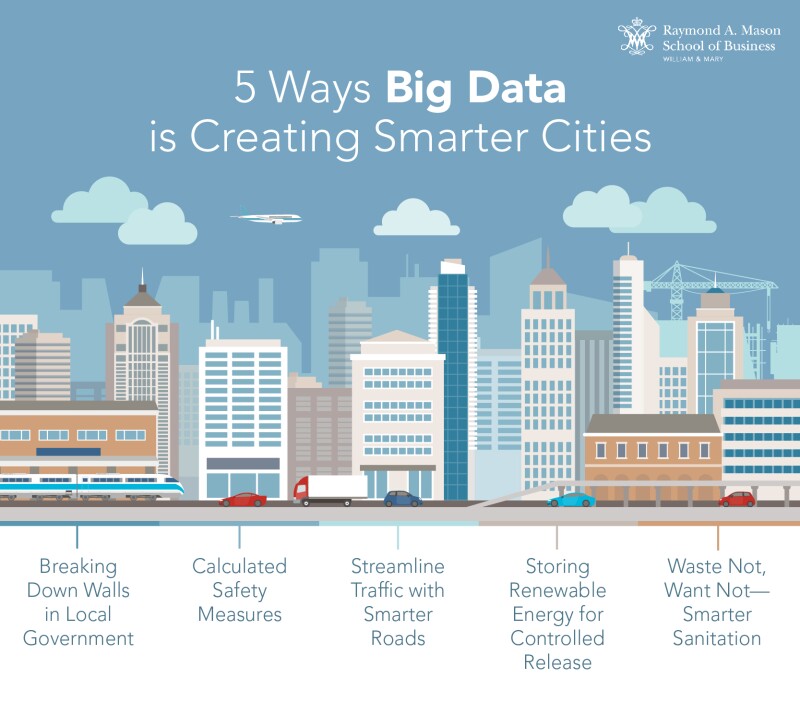Welcome to the Smart City Revolution
Just as data and data analytics can be leveraged to improve business performance, the same tools can also be used to improve livability, workability and sustainability in cities around the globe. In many ways, the future of smart cities is likely what you’d expect, with implications for roadways and renewable energy, but some of the possibilities may surprise you.
Rethink tomorrow’s lay of the land with a look at five ways big data is building smart cities.
Breaking Down Walls in Local Government
Every department within your city government collects information—data—about you and your household. Frustratingly, in many cities, this information is siloed, which means that every time you walk into a municipal office, whether you want to pay your property taxes or apply for a construction permit, you have to provide the same information on yet another form. But introducing the appropriate platforms to share data transparently could easily eliminate this issue.1
Imagine: Instead of scattered piecemeal at every city office you’ve visited, your vital data would be stored centrally and could be easily shared across departments to facilitate smoother service. At the same time, this approach could generate greater awareness among city officials regarding what problems their constituents are routinely trying to address.
Calculated Safety Measures
Fire detector distribution programs are common in American cities. New Orleans was one among them—making smoke alarms available to any resident who requested their installation. But when five people, including three children, died in a fire in a home where no smoke alarm was present, the city decided to take a new approach.
Since 2015, the New Orleans Fire Department and the city’s Office of Performance and Accountability have been collaborating to determine which homes in the city were least likely to have smoke detectors but were at potentially increased risk for fire. They went door-to-door collecting information and developed a data-driven model that resulted in a more targeted approach for alarm distribution.2 Ultimately, this approach has saved lives by getting smoke detectors into the homes that really needed them, and it is a model for cities that want to get smarter about safety.3
Streamline Traffic with Smarter Roads
In 2017, Uber and the city of Pittsburgh began experimenting with self-driving taxis. Some initial missteps, which included cars getting confused by the presence of trees, suggested that driverless ride-sharing may not be ready in the immediate future. However, while this concept may not be a scalable reality yet, analysts do envision a future in which feedback between city roads, cars and passengers will be the backbone of the self-driving car revolution. Of course this endeavor will require an immense amount of data, as instantaneous tracking will have to include road conditions, traffic patterns and both car-to-car and car-to-road interactions.
Still, great things can be achieved when the journey is taken one small step at a time. One way to intelligently improve traffic? Improve parking. In the United Kingdom, infrastructure is currently in place for the real-time tracking of available parking spots, which will theoretically reduce the amount of time drivers spend looking for parking and alleviate congestion on the streets.4
Storing Renewable Energy for Controlled Release
Historically, city energy grids are heavily taxed during severe weather or on particularly hot days—when people crank up the AC—and this can sometimes lead to power failures. But analysts are now investigating new ways to combine storable energy that could create a kind of buffer around traditional energy grids. For a properly equipped smart city, renewable energy storage could combine power sources like solar energy and wind farms with insights about usage fluctuation and weather conditions to help regulate the burden on the electrical grid.5 In turn, this could be a positive solution for keeping lights on in homes during a storm and increasing energy reliability during what are predicted to be other high-usage times.
Waste Not, Want Not—Smarter Sanitation
With a population of three million people, the Indian city of Pune is experiencing a sanitation crisis, with an estimated 64 percent of its waste going untreated. But city leaders in Pune are tackling the problem head-on by partnering with private companies to leverage a smarter approach. An interesting example of their efforts? Public toilets have been equipped with Wi-Fi-enabled sensors that will empower city sanitation crews to focus their efforts on area facilities that are used most often. It may sound silly, but by knowing which toilets are most frequently used, Pune officials could stop the next E. coli or cholera outbreak.6
Anticipating the Future of the Smart City
In two years, experts estimate that the smart city market will be worth $1.4 trillion,7 and the impact of leveraging data to improve urban life seems truly limitless. By 2020, Uber could begin testing autonomous flying taxis in Dallas and Dubai. By 2030, connected traffic lights could help to improve a city's traffic, air quality, public safety and parking (while saving money by improving light usage). And by 2050, your takeout meal and Amazon package might be delivered by drone.
It's truly too soon to tell how profoundly connected technologies will revolutionize urban dwelling. But one thing's for sure: the cities that manage their data smartly will be the ones to thrive.
Looking for your place in big data and the smart city revolution? Consider how earning an Online Master of Science in Business Analytics could equip you with the insight and understanding needed to make the possible, probable.
- Retrieved on January 30, 2018, from techrepublic.com/article/6-ways-cities-will-become-smarter-in-2017/
- Retrieved on January 30, 2018, from nola.gov/performance-and-accountability/reports/nolalytics-reports/full-report-on-analytics-informed-smoke-alarm-outr/
- Retrieved on January 30, 2018, from datasmart.ash.harvard.edu/news/article/predicting-fire-risk-from-new-orleans-to-a-nationwide-tool-846
- Retrieved on January 30, 2018, from information-age.com/smart-cities-will-lay-way-autonomous-cars-123468202/
- Retrieved on January 30, 2018, from na.smartcitiescouncil.com/article/why-its-time-cities-get-smart-about-energy-storage
- Retrieved on January 30, 2018, from fastcompany.com/40466766/the-quest-to-use-big-data-and-community-toilets-to-create-a-model-for-building-urban-sanitation
- Retrieved on January 30, 2018, from orange-business.com/en/magazine/smarter-healthcare-in-smart-cities

